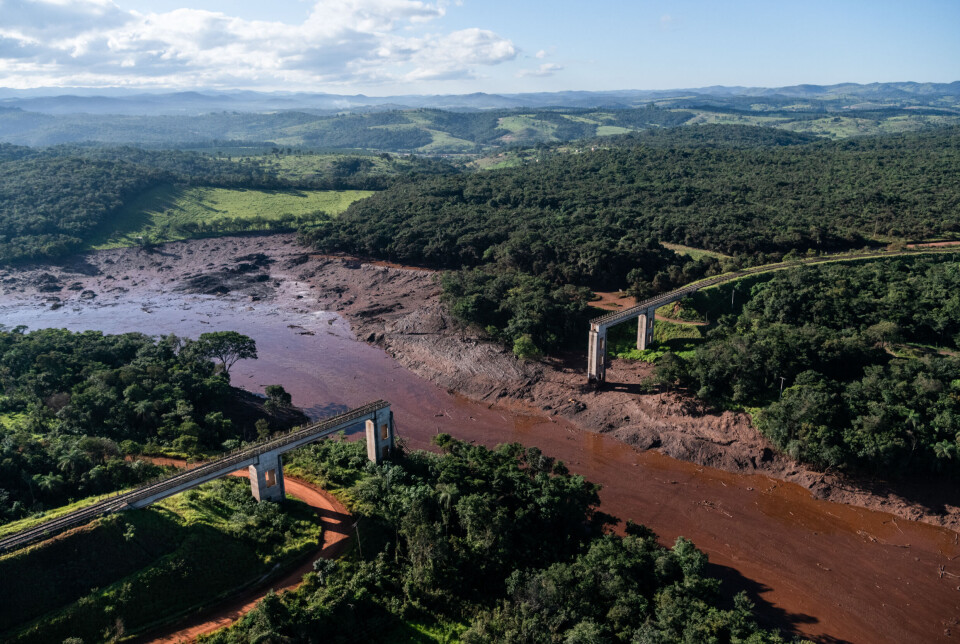THIS CONTENT IS BROUGHT TO YOU BY NGI - the Norwegian Geotechnical Institute - read more
This determines how dangerous a dam failure can be
When a mining dam burst in Brazil in 2019, nearly ten million cubic metres of toxic sludge surged down the valley, claiming over 270 lives. A Norwegian study shows what may be crucial for understanding the consequences of such a failure.

To extract metals such as iron, copper, or gold, rock is crushed into powder and mixed with large amounts of water and chemicals.
The result is a wet, muddy mass – mine waste – which must be stored safely. A tailings dam is an artificial reservoir that retains waste from mining operations.
Mining companies therefore build dams to contain this waste. Behind such dams, enormous amounts of sludge and water can accumulate, effectively forming artificial lakes.

Dam height matters
If a dam fails, the consequences can be catastrophic.
A well-known example is the Brumadinho disaster in Brazil in 2019, where almost ten million cubic metres of sludge poured out. The flood wave killed more than 270 people and devastated the valley’s environment for decades to come.
Researchers at the Norwegian Geotechnical Institute (NGI) have analysed an updated global database of dam failures.
The goal was to determine which factors best explain how much material is released when a dam collapses.
“Previously, the total storage volume was often used to indicate how much could be released. We’ve shown that by including the dam's height, you get a more accurate estimate of the released volume,” says researcher Luca Piciullo, who led the study. He works as a senior specialist in dam safety at NGI.
The upstream method stands out
The analysis also shows that the construction method plays a significant role in safety. The so-called upstream method – where new dam layers are built on top of wet tailings – is clearly overrepresented in the accident statistics.
“The method is inexpensive and widely used, but produces a less stable structure. Our data confirm that upstream dams are especially vulnerable to liquefaction, a phenomenon in which solid materials suddenly lose their strength and begin to behave like a liquid. In Norway, we see a similar effect in quick clay slides,” explains Piciullo.
The researchers also investigated whether the size of the water surface – the area of water that collects on top of the dam – affects how much sludge is released in a dam failure.
Contrary to earlier assumptions, they found no such correlation.
A more reliable method
“Our research aims to provide both the industry and research community with a more reliable, data-driven method for estimating how much material will actually be released if a tailings dam fails,” says Piciullo.
The article was selected as one of Engineering Geology's six best publications from the past three years, based on peer review and citations.
Reference:
Piciullo et al. A new look at the statistics of tailings dam failures, Engineering Geology, vol. 303, 2022. DOI: 10.1016/j.enggeo.2022.106657
———
Read the Norwegian version of this article on forskning.no

This content is paid for and presented by the Norwegian Geotechnical Institute
This content is created by the Norwegian Geotechnical Institute's communication staff, who use this platform to communicate science and share results from research with the public. The Norwegian Geotechnical Institute is one of more than 80 owners of ScienceNorway.no. Read more here.
More content from NGI:
-
PFAS: This could stop the dangerous chemicals from leaking into the environment
-
Will it be possible for humans to build and live on the Moon for extended periods of time?
-
NGI-led EU project will digitise the mining industry and ensure increased sustainability
-
Linking art and research to disseminate knowledge on plastic pollution
-
Your teflon frying pan and shampoo release invisible pollution. Huge EU project aims to stop this
-
Establishing a plastics recycling plant in a refugee camp in Ethiopia




































